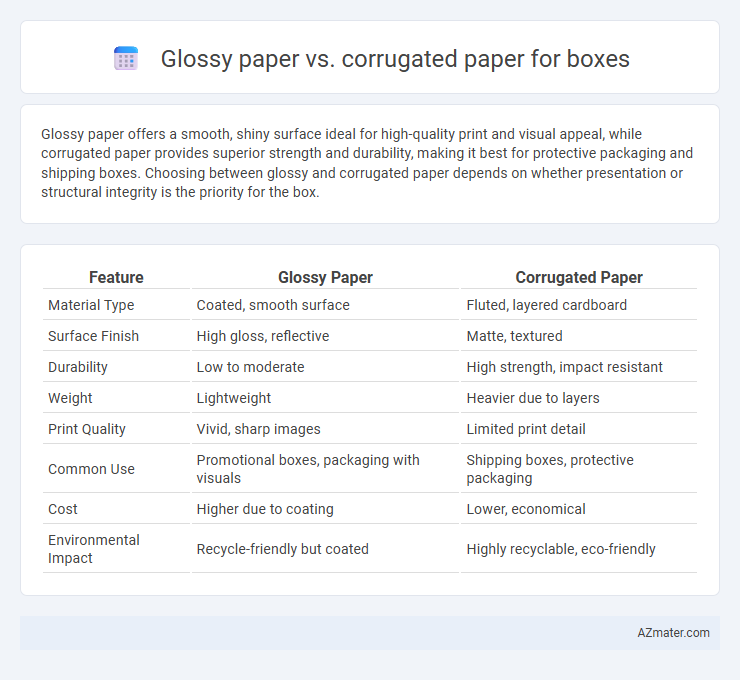Glossy paper offers a smooth, shiny surface ideal for high-quality print and visual appeal, while corrugated paper provides superior strength and durability, making it best for protective packaging and shipping boxes. Choosing between glossy and corrugated paper depends on whether presentation or structural integrity is the priority for the box.
Table of Comparison
| Feature | Glossy Paper | Corrugated Paper |
|---|---|---|
| Material Type | Coated, smooth surface | Fluted, layered cardboard |
| Surface Finish | High gloss, reflective | Matte, textured |
| Durability | Low to moderate | High strength, impact resistant |
| Weight | Lightweight | Heavier due to layers |
| Print Quality | Vivid, sharp images | Limited print detail |
| Common Use | Promotional boxes, packaging with visuals | Shipping boxes, protective packaging |
| Cost | Higher due to coating | Lower, economical |
| Environmental Impact | Recycle-friendly but coated | Highly recyclable, eco-friendly |
Introduction to Glossy and Corrugated Paper
Glossy paper features a smooth, shiny coating that enhances printed images with vibrant colors and sharp details, commonly used for high-quality packaging and promotional boxes. Corrugated paper consists of a fluted corrugated sheet sandwiched between two liners, providing superior strength, durability, and cushioning, making it ideal for shipping boxes and heavy-duty packaging. Choosing between glossy and corrugated paper depends on the balance between visual appeal and structural protection required for the box's purpose.
Key Differences Between Glossy and Corrugated Paper
Glossy paper offers a smooth, shiny finish that enhances print quality and vibrant color reproduction, ideal for promotional packaging but less durable for heavy-duty use. Corrugated paper consists of fluted layers sandwiched between liners, providing superior strength, cushioning, and protection, making it perfect for shipping and industrial boxes. The key differences lie in their texture, strength, and application, with glossy paper prioritizing aesthetics while corrugated paper emphasizes durability and impact resistance.
Durability: Which Material Offers Better Protection?
Corrugated paper offers superior durability for box protection due to its multi-layered structure that absorbs shocks and resists crushing, making it ideal for transporting heavy or fragile items. Glossy paper, while visually appealing with a smooth, shiny finish, lacks the rigidity and cushioning necessary for robust protection. For shipping or storage where impact resistance is critical, corrugated paper remains the preferred choice for durability and strength.
Aesthetic Appeal: Glossy Shine vs. Textured Finish
Glossy paper offers a vibrant shine and smooth surface that enhances colors and graphics, making boxes visually striking and ideal for premium packaging. Corrugated paper provides a textured finish with a natural, rustic look that conveys durability and eco-friendliness, appealing to brands seeking an organic aesthetic. Choosing between glossy shine and textured finish depends on the desired brand image and product presentation.
Printing and Customization Capabilities
Glossy paper offers superior print quality with vibrant colors and sharp details, making it ideal for high-end packaging that requires eye-catching graphics and intricate designs. Corrugated paper provides a durable printing surface suitable for large-scale branding but typically yields less vivid prints due to its textured and absorbent nature. Customization on glossy paper supports a wide range of finishes, such as UV coating and laminations, while corrugated paper customization emphasizes structural modifications and eco-friendly print options.
Cost Comparison: Glossy Paper vs Corrugated Paper
Glossy paper boxes typically cost more due to higher material expenses and printing complexity, offering a sleek finish ideal for premium product packaging. Corrugated paper boxes are more cost-effective, providing durability at a lower price, commonly used for shipping and bulk packaging. Choosing between glossy and corrugated paper depends on budget constraints and the need for aesthetic appeal versus strength.
Environmental Impact and Sustainability Factors
Glossy paper boxes often involve coatings or laminates that reduce recyclability and increase environmental impact due to chemical treatments, whereas corrugated paper boxes are typically made from recycled fibers and offer higher biodegradability and easier recycling processes. Corrugated boxes support sustainability by using renewable materials and enabling multiple recycling cycles, contributing to a lower carbon footprint. Choosing corrugated paper boxes aligns with circular economy principles, minimizing waste and promoting resource efficiency in packaging solutions.
Best Uses for Glossy Paper in Packaging
Glossy paper is ideal for packaging that requires high-quality visual appeal and vibrant color reproduction, making it perfect for luxury product boxes, cosmetics, and gift packaging. Its smooth, shiny surface enhances brand presentation and provides excellent print clarity for detailed graphics and logos. Glossy paper also offers moderate durability suitable for lightweight items but is less effective for heavy or bulky packaging compared to corrugated paper.
Ideal Applications for Corrugated Paper Boxes
Corrugated paper boxes excel in packaging heavy or fragile items due to their superior strength and cushioning properties, making them ideal for shipping electronics, appliances, and industrial goods. Their lightweight yet durable structure provides excellent protection against impacts and environmental factors during transport and storage. These boxes are also preferred for bulk packaging and palletizing, where robust stacking and load-bearing capacity are essential for efficient logistics.
Choosing the Right Paper Type for Your Packaging Needs
Glossy paper offers a smooth, shiny finish ideal for high-end retail packaging, enhancing visual appeal and brand perception, while corrugated paper provides superior durability and cushioning, making it perfect for shipping and protecting fragile items. Selecting the right paper depends on factors like product weight, fragility, branding requirements, and shipping conditions to balance aesthetics and functionality. For premium presentation, glossy paper elevates shelf impact, whereas corrugated paper ensures cost-effective protection during transit.

Infographic: Glossy paper vs Corrugated paper for Box
 azmater.com
azmater.com